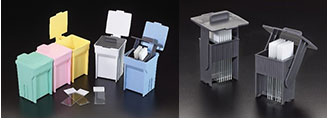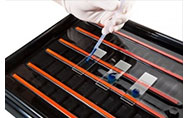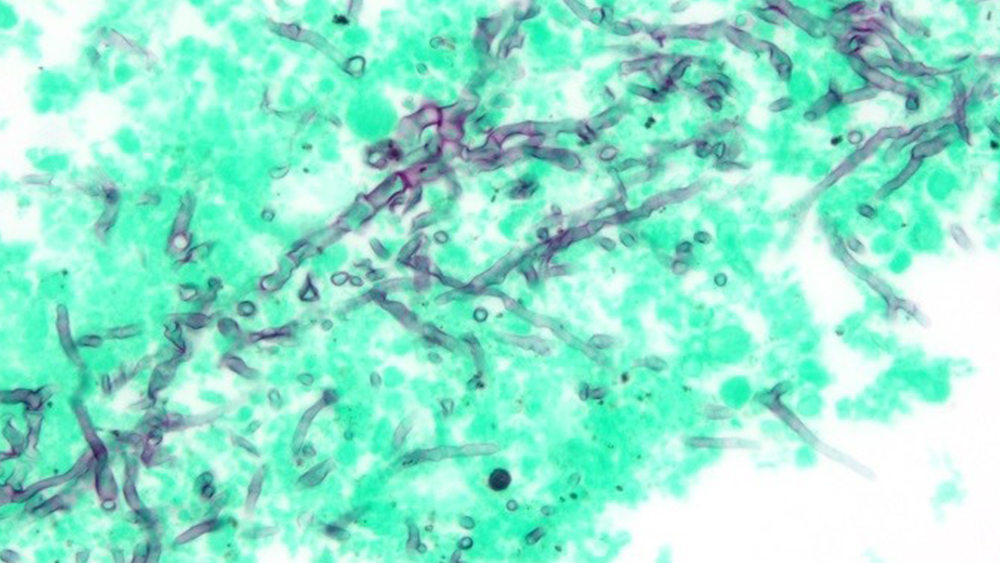Accessories for Routine, Special, & IHC Stains
Herbert Skip Brown, M. Div. HT(ASCP)
Lab Storage Systems, Inc.
The expansion of special staining as a diagnostic tool in histopathology saw a meteoric increase in the 1980s and 90s. Special stains had always been a comfortable diagnostic confirmation to pathologists to support the routine H&E stain, but with the rise in bone marrow studies, liver panels, GI biopsies, and others during this period, stains such as Trichrome, Reticulin, Steiner, etc., became routine panels run daily.

With the onset of IHC staining panels being added to this, subsequently, there was a need, even a mandate, for automation. This became problematic with many of the senior Histotechnologists who had developed special techniques to optimize the effectiveness of the stain to reduce/eliminate precipitates and background staining. It was felt that many of the patient tissues required special technique and individual monitoring, such as with silver stains, to achieve optimization. Further, more complex stains requiring differentiation (acid-fast), silver reduction (GMS, Steiner-Steiner), etc. could not be accomplished through a general standard procedure for all slides. In the early 1990s innovations in technology proved this wrong, as one of the first automated instruments for special stains was released into the industry; one that could optimize among other procedures, silver staining.
The cost of automated special stainers was restrictive to smaller labs or labs that did not have the volume inpatient tests to justify. While the science of making up most of the dyes and stains in the lab became replaced by commercial stain kits, Histologists used stain accessory items such as Coplin jars, stain trays, forceps, etc. to perform the tests.e Design settings and even apply custom CSS

to this text in the module Advanced settings. Traditional glass Coplin jars were modified into organized staining rack systems with durable acetyl polymer jars that were break-resistant and could be used in a linear arrangement for a stain procedure, or individually for a single dye step.

In this type of staining, slides were placed in a modified slide holder that gave greater control and dexterity with the slides; then bulk-stained as a set. Staining requiring individual application of stain or reagent saw the creation of horizontal staining tray systemswhere stains and reagents could be individually applied to slides,then washed and rinsed with less handling of each slide.

The tray system was revolutionized even further to include a drain plug, staining lid to create a humidity chamber, and special polymer strips on the rails that could hold the slides when rinsing at an angle. Special staining in this type of stain tray system can even be expanded to perform immunofluorescent staining by use of a black stain cover instead of clear.
Admittedly, automation streamlines the process of slide staining, particularly with high volume or limited staffing resources; but for those labs that dont have the volume or capital funds to support the cost of instrumentation, manual staining is a viable option to still achieve patient testing and avoid the cost of sending cases out to a reference lab. Even for those labs that have automated, manual staining, gives you the ability to still provide remote stain requests that may be ordered only once or twice a year; as opposed to ordering stain kits that will undoubtably expire before it is used up. With specific stain accessories, stain procedures can be temporarily set up and broken down when finished, minimizing wasted space and resources, all while maintaining a lean caseflow system.
Lab Storage Systems has a full line of staining accessories including linear rack systems with individual removable stain/reagent containers, stain trays designed with SMART technology, to slide folder and holder, forceps, etc. Please contact your customer service representative today for additional information.

